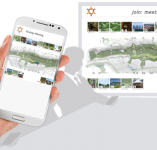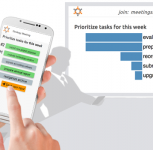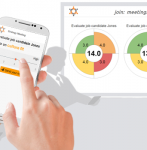The idea behind innovation meetings is that participants will build off of one another’s ideas, creating a product of their collective intelligence that is better than what each of them could have come up with on their own.
Even if no one member of the team has a brilliant idea, much better ones can result from sharing and combining insights from people with complementary insights and experience. Innovation meetings and creative meetings often start with thinking outside the box; brainstorming, associating, and sharing ideas in a broad scope.
Meeting participants can then use various techniques and processes to reduce the diverse pool of ideas to a more focused short list. Through ranking, evaluations, and decision making, the most suitable idea, or ideas, are identified, and recommendations and tasks can be assigned.
Primary Goals for Innovation Meetings
Meetings where the main focus is to come up with new ideas, designing or redesigning products, or developing entirely new approaches for your business, can all be defined as innovation meetings.
Identify a new or redesigned approach
The primary goal of an innovation meeting is to leave with either a new or redesigned approach to a current project or problem.
Key Roles in Innovation Meetings
Innovation meetings typically happen at the beginning of a project timeline, where the final goal has not yet been defined or refined.
The most driven teams usually have their goals and direction aligned early on in the process. Thus, especially with smaller teams, it is often helpful in the long run to include as many team members as possible in the early planning process. This way, everyone feels ownership and responsibility for the goal, you can tap into everyone’s knowledge and expertise, and no one feels that they are assigned to work on something they did not agree with.
Meeting leader
As with most meetings, it can be helpful to have a meeting leader in charge of directing the flow of ideas. However, meetings built around brainstorming should also be some of the least hierarchical that your team is involved in. This is because the process of freely generating and sharing ideas can be hampered when people feel like they are being told how to respond by an authority.
Meeting participants
At innovation meetings it is important to have a variety of perspectives and experiences present. True innovation is often a result of combining elements and approaches from at least two different fields. It can be beneficial to include a few participants that are less familiar with the area that you seek to innovate, to provide a fresh perspective and potentially question stale assumptions.
Note taker
One crucial role to innovation meetings in particular is that of a note taker. Not only should ideas be written down, but comments and concerns brought up in the discussion about ideas should also be recorded. All too often, the first choice of ideas don’t work out. In this case, rather than brainstorming all over again, a team can simply refer back to their meeting report in order to see what the next best ideas were and begin working on them right away.
Common Challenges in Innovation Meetings
We often attribute the most brilliant inventions or creations to one person, but the truth is that ideas really take shape when being bounced between multiple people with different perspectives.
This is why we do so much of our brainstorming in groups. But inspiring and facilitating free idea sharing and discussions in groups may present some challenges.
Creating an inspiring environment
Most people who have attended a handful (or truckload) of meetings know what a high-functioning brainstorm feels like. This kind of meeting generally has participants spit-balling ideas off of each other, working with one another without feeling reserved to create something brilliant by combining and building off of each other’s ideas. Meetings like this may feel rare and spontaneous, but there are certain techniques any meeting leader can bring to a meeting to get the ideas flowing.
Freely sharing ideas without judgement
Unlike your company vision, which is carefully crafted by the leadership, innovation can originate from anywhere in the organization. Creating a meeting culture where a junior employee’s fresh observation is freely shared and given the same consideration as a seasoned executive’s ideas can be challenging.
Tapping into different perspectives
In day-to-day enterprise collaboration, different views are often played down to unify the team and move together in the same direction. In innovation, the creative interaction between two, or more, different perspectives is what produces new solutions. It can be challenging to truly bring this change of mindset out in innovation meetings.
How to Host Successful Innovation Meetings
Innovation usually starts with broad, creative thinking, often in the form of a brainstorm in which many ideas are generated and shared. These suggestions are then narrowed down into a more concise list which can be refined, evaluated, and discussed in order to highlight the drawbacks and benefits of each idea. Through group assessment, evaluations, and various voting methods, a final choice is made and a best path is determined. Once this has been done, steps for bringing this idea to life can be discussed and tasks can be assigned to members of the team.
Set the stage and generate flow
Sparking the kind of idea exchange that works best in innovation meetings can be difficult. However, any meeting leader or participant can start the process by asking the right questions. Try initially sparking a conversation about team goals and priorities to narrow the focus of the meeting. It can also be helpful to have involved or passionate members share the importance of what the team is setting out to do. These kind of introductory activities help get members focused and inspired to begin the process of innovation.
Brainstorm and evaluate ideas
Any kind of brainstorm is sure to originate some ideas which may or may not be brilliant. But in general the more ideas you initially generate, the bigger chance there is for there being some diamonds in the rough among the contributions. Begin with some activities that spark interest and excitement among the team and record all ideas. We suggest that as many people and ideas as possible should try to be incorporated into any early brainstorming session. Once a large number of ideas have been contributed, the process is then to refine and evaluate them, before categorizing them into practical steps.
Involve stakeholders to ensure follow-through
The majority of ideas and contributions in innovation meetings will probably be scrapped. However, when stakeholders know that their ideas are being taken into consideration and compared to the other possibilities, they feel like they have been part of the process and are more likely to be supportive of the final decision. This kind of group alignment can be essential to successfully moving forward.
Better Innovation Meetings with Technology
For the best ideas, and true innovation, you need human interaction, conflict, argument, and debate. MeetingSift helps you better facilitate such interaction by providing easy to use group activities for brainstorming, prioritizing, evaluating, and making decisions.
Use MeetingSift to create environments where out-of-the-box ideas can be shared without judgement. Where different perspectives are visualized side-by-side. And where the group’s collective intelligence can be harvested effectively and efficiently.
Safely share ideas anonymously
MeetingSift Brainstorm Activity supports anonymous idea sharing, putting the focus on the idea rather than the person behind it. This lets the group consider each idea on it’s own merit. The best ideas lose their owners and take on lives of their own.
Quickly and easily capture ideas from any size group
MeetingSift lets you easily and efficiently gather ideas, feedback, opinions, and evaluations from groups of any size.
Recording and sharing ideas in larger groups can be a difficult task when several dozen people are juggling hundreds of Post-it Notes or shouting suggestions across the room.
MeetingSift allows participants to submit ideas and feedback on their mobile device. Their ideas are then displayed for the rest of the group to see and build upon. This kind of parallel input saves time and also removes any potential bias introduced by the order of which the ideas were presented. The collective intelligence of the group is visualized in real-time, enhancing the discussion and group alignment.
Visualize everyone’s opinions in real-time
MeetingSift visualizes participants’ ideas, feedback, and opinions in real-time. Feeding this valuable information back into the discussion not only enriches it, but saves time.
Instead of a room full of “yes-men”, you get to tap into the group’s true thoughts and ideas. Especially helpful for large groups is the word cloud generated out of submissions, highlighting the most frequently submitted words or ideas.























